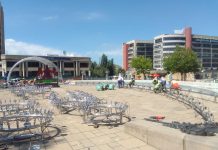Africa-Press – Lesotho. Africa’s cities are growing, but without the accompanying economic transformation — keeping them in a ‘low-development trap’.
Given the abundance of natural resources in the continent, it is a tempting proposition to think that Africa’s economic prosperity lies in the efficient management of resource revenue.
But this would be wrong. The future of Africa lies in its cities – and all evidence indicates that the continent is in serious risk of jeopardising that future.
The World Bank states that urbanisation “is the single most important transformation that the African continent will undergo in this century”.
Over half of the African population is projected to live in cities by 2040, rising from the current level of 4Source, UN World Urbanization Prospects 2014, WEF
This is part of a historical trend. There are many implications for urbanisation in Africa – chief of which is that policy priority should reflect this reality.
Africa Insight Wake up to the essential with the Editor’s picks. Consumption of goods and services on the continent is driven by over 300 million people, most of who reside in cities. Despite the emphasis on agriculture by policymakers and donors, most young Africans find opportunities in cities more attractive than farming.
Firms in the most valuable industries like finance, information technology, retail and manufacturing, find the most productive workers in cities – in line with the evidence that the most motivated and productive of the rural population end up moving to cities.
Urban economist Edward Glaeser called cities “our species’ greatest invention” – because cities contribute to human enrichment by exploiting the intrinsic benefits of having humans living in close proximity.
One theory for the inevitable rise of urbanisation is economic development through what economists call structural transformation. For the most part of human history, our main economic means was through agriculture.
Long distance trade and export of primary harvests financed the construction of early cities. But with agricultural productivity (through technical improvement) and population growth, there was a significant surplus of farm workers.
The result was migration of rural farmers to burgeoning urban centers to seek economic opportunities. This is the rural “push effect”. The coming of the Industrial Revolution saw the second great wave in urbanisation.
Factory jobs were better paying and more consistent than agricultural harvest for some farmers. Many of them abandoned rural life to try their luck in industrial towns and cities. Industrial productivity and expansion of industrial production further attracted and absorbed many more rural farmers as industrial workers.
Although these created new challenges like pollution and food security, safety standards were later improved through regulation, and food imports were the buffer for countries with a comparative advantage in manufacturing.
In Africa, economic development and urbanisation appear to be decoupled. Africans are moving to cities at historically lower incomes. A World Bank study concluded that African cities are stuck in a “low-development trap”.
The result is that city dwellers and firms are locked out of the intrinsic benefits of urban development. Emergent urban patterns in Africa are cities that are fragmented, disconnected, and costly.
This is caused by low infrastructure investment and the prevalent urban building patterns. Cities are labour markets that matches firms and job-seekers, but disconnection raises the costs of matching, with firms feeling the heat from higher wage demands without productivity gains.
Manufacturing firms in African cities pay a higher nominal wage than firms in other regions. Consequently the rate of investment slows down and physical infrastructure fail to match population growth.
African cities are also expensive. The overall urban dynamics in African cities is one of negative path dependence. African cities are avoided by global and regional investors and trading partners due to low expectation of returns.
This leads to low investment, and means the current inefficient urban forms remain in place. Fixing Africa’s urban challenges requires breaking the low-development logjam.
The triple threat of fragmentation, disconnectedness, and costliness must be confronted. The first step on this path is the formalization of land markets. But there are also costs.
Formalizing land rights can be as high as $3000 per parcel of land in Tanzania while a community-based land regularisation project in Rwanda reduced costs to about $6 per parcel of land.
Such experimental approach is needed and needs to be done openly and fairly. The distribution of urban land must also be shielded from state capture – where politicians and their cronies transfer valuable land for personal use.
Stimulating investment in urban development requires more than any isolated infrastructure spending or project. The low expectation that deter investment commitments is a coordination problem and can only be solved through coordinated actions.
The principal actor may be the city government, a group of firms or large scale land developers. Urban forms can maintain their equilibrium state for up to 150 years, and, because dysfunctional urban forms in Africa may see such persistence, coordinated solutions may require bold new experiments like charter cities.
Bottom line: Building new cities will enable the right mix spontaneous economic connection and effective urban planning. This will open African cities to global value chains for trade, manufacturing, more investments, and technology transfer.
For More News And Analysis About Lesotho Follow Africa-Press






